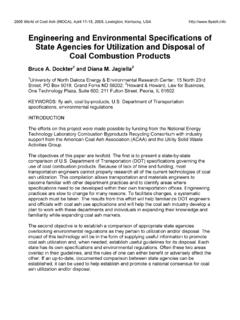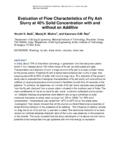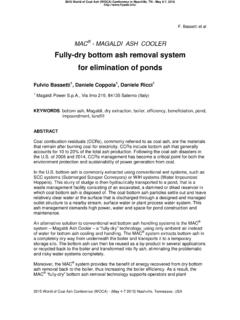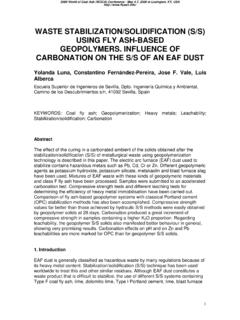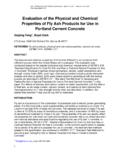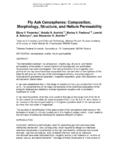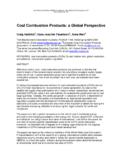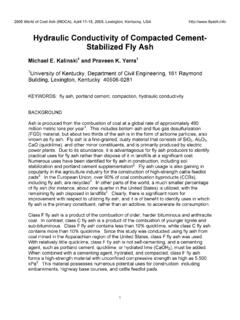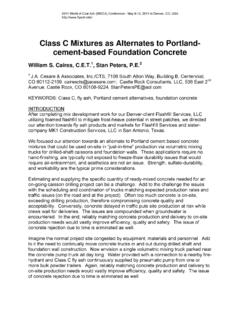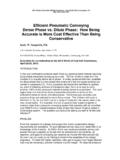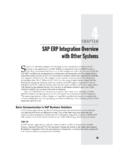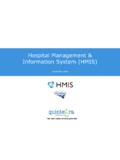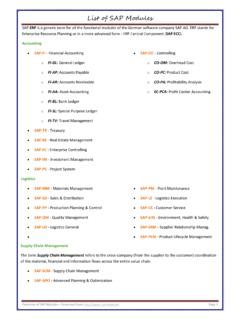Transcription of How to Manage a Statistically Significant Increase (SSI ...
1 2017 World of Coal Ash (WOCA) Conference in Lexington, KY - May 9-11, 2017. How to Manage a Statistically Significant Increase (SSI) during groundwater detection monitoring under the CCR Rule Bob Glazier, and Bruce Sass, 1 Geosyntec Consultants, Inc., 10211 Wincopin Circle, 4th Floor, Columbia, MD 21044. 2 Geosyntec Consultants, Inc., 150 E. Wilson Bridge Road, Suite 232, Worthington, OH. 43085. KEYWORDS: SSI, forensics, alternative source, groundwater , CCR Rule ABSTRACT. Utilities managing coal combustion residuals (CCR) that are regulated by the Federal CCR Rule face the possibility of a bump in the road ahead: a Statistically Significant Increase (SSI) above background concentrations in groundwater during detection monitoring .
2 An SSI is the first indication of a potential release to groundwater that might lead to additional investigations and, more importantly, costly and protracted groundwater remediation measures. However, SSIs may occur even if no release from the regulated unit has occurred. According to some interpretations of the CCR Rule, an SSI could occur as early as October 2017. Key initial considerations and decisions that should be undertaken when an SSI occurs are presented along with common misconceptions. In addition to evaluating the possibility of a false positive statistical results, these considerations include potential misunderstanding and/or misapplication of statistical methods, an incomplete conceptual site model, operator knowledge regarding the likelihood of a release, and alternative sources of the SSI constituent(s).
3 Decisions to pursue these possibilities or to proceed with assessment monitoring and corrective measures must be made quickly under the CCR Rule schedule constraints. Therefore, advance planning for the possibility of an SSI is critical. The use and importance of a defensible conceptual site model during these considerations is emphasized. Several approaches to geochemical forensics that are useful in identifying alternative sources for the SSI offer the potential to avoid costly and unnecessary remedial measures. INTRODUCTION. Utilities managing coal combustion residuals (CCR) that are regulated by the Federal CCR Rule1 face the possibility of a bump in the road ahead: a Statistically Significant Increase (SSI) above background concentrations in groundwater during detection monitoring .
4 An SSI is the first indication of a potential release to groundwater and might lead to additional investigations and, more importantly, costly and protracted groundwater remediation measures. However, SSIs may occur even if no release attributable to the regulated unit has occurred. This paper discusses some of those false positive scenarios. OVERVIEW OF groundwater detection monitoring IN THE CCR RULE. monitoring system/performance standards According to 40 CFR , the performance standard for the groundwater monitoring system is to install a groundwater monitoring system that consists of a sufficient number of wells, installed at appropriate locations and depths, to yield groundwater samples from the uppermost aquifer that: (1) Accurately represent the quality of background groundwater that has not been affected by leakage from a CCR unit.
5 A determination of background quality may include sampling of wells that are not hydraulically upgradient of the CCR. management area and (2) Accurately represent the quality of groundwater passing the waste boundary of the CCR unit. The downgradient monitoring system must be installed at the waste boundary that ensures detection of groundwater contamination in the uppermost aquifer. All potential contaminant pathways must be monitored.. Item (1) allows for placement of background wells that are not hydraulically upgradient of the subject CCR unit (see Figures 1 and 2).
6 If there are upgradient CCR units with releases to groundwater , the resulting groundwater quality between the two units is not considered background' under the CCR rule and requires installation of background wells that are not directly upgradient from the regulated unit. Note that item (1) above states leakage from a CCR unit not leakage from the CCR unit [emphasis added]. In that case, background should be established using wells in another location, such as side gradient of both units and groundwater quality between the two units is addressed as part of an alternative source demonstration as described later in this paper.
7 Figure 1: Plan view monitoring system without upgradient CCR unit release Figure 2: Plan view monitoring system with upgradient CCR unit release Item (2) requires that the monitoring system ensures detection of contamination. This is clearly an impossible task, even with closely spaced monitoring wells. It should be noted that this requirement is derived from the RCRA Municipal Solid Waste (MSW). regulations (40 CFR Part 258) and therefore it is recommended that monitoring systems be designed in accordance with generally accepted local practice in the industry for MSW landfills.
8 This could provide a useful defense in the event of litigation. Compliance with the above performance standards should be addressed by developing, along with other lines of reasoning, a defensible conceptual site model (CSM) during monitoring system installation. More complex hydrogeologic settings will require a more robust CSM. The CCR rule includes additional requirements for the groundwater monitoring system and should be consulted for those details. Among them is the requirement for a minimum of one background and three downgradient wells. Installation and monitoring of more than one background well is highly recommended for several reasons.
9 First, more than one well should capture spatial variability in background concentrations that might also be present in the downgradient wells. Second, it allows for potential loss of some data while still meeting the minimum requirements for the number of background samples. For example, one background well might unexpectedly go dry during baseline monitoring due to drought. Third, it eliminates the need for extra justification that the CCR rule requires if the minimum number of wells is used. Existing units regulated by the CCR Rule are required to install groundwater monitoring systems and collect at least eight (8) baseline groundwater samples for the analytes listed in Appendix III (indicator parameters for detection monitoring ) and Appendix IV.
10 (assessment monitoring parameters) from each background well and each downgradient compliance well by October 17, 2017. It is recommended that the facility establish a Sampling and Analysis Plan (SAP) so that, in the event of litigation, a written plan can be said to have been followed when generating the baseline data. It is preferable to have a SAP prior to collection of the baseline samples. Statistical methods can be added as an addendum to the SAP after the baseline monitoring and initial statistical evaluation are completed. Analytical parameters during collection of the eight or more baseline monitoring samples, both Appendix III.
